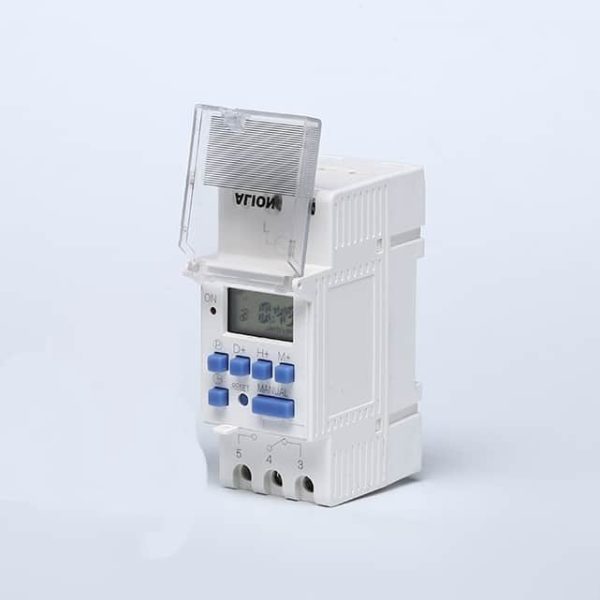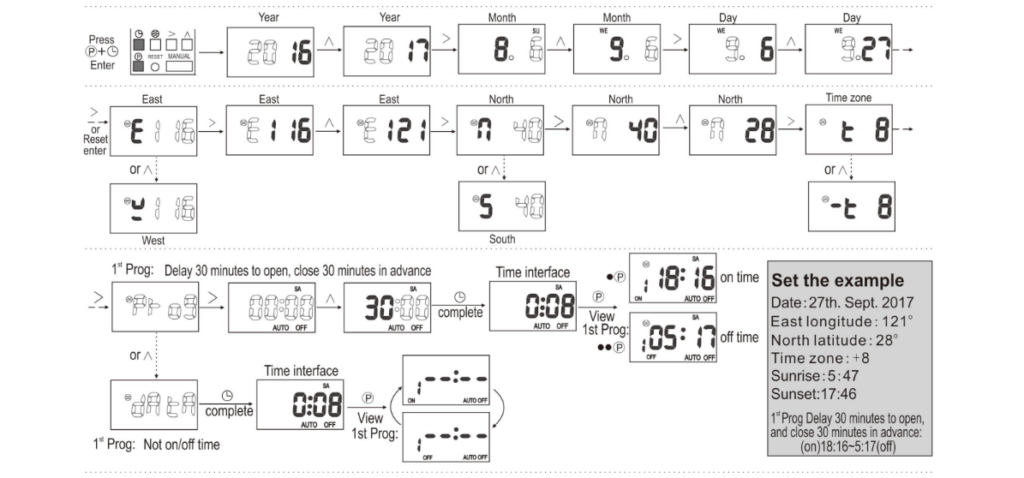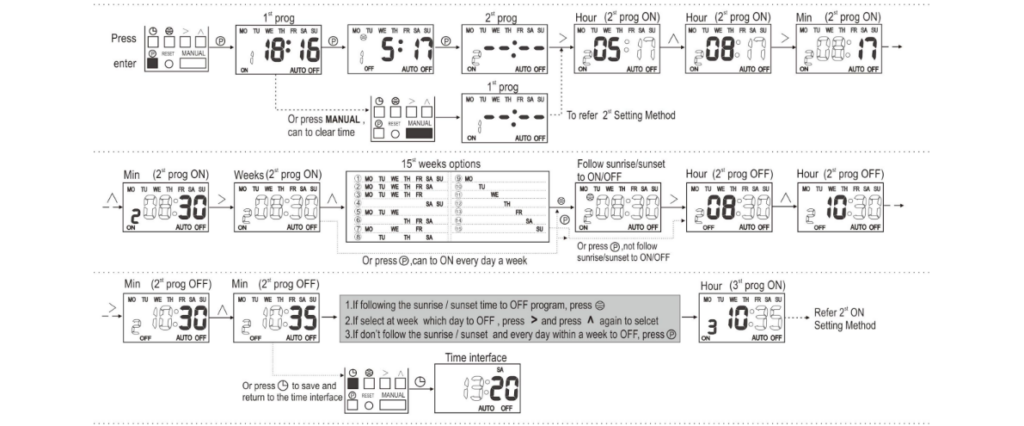Astronomical time switches are commonly used for street lighting and industrial use.
This article tackles the nitty-gritty stuff about automatic timers. So, read on to learn more.
What is An Astronomical Time Switch?
The astronomical time switch is an industrial device that monitors and responds to the varying positions of the sun throughout the year.
It functions like a regular timer, but it is set with specific program settings based on information provided by satellites and other inputs.
Unlike 24-hour-traditional timers, the astronomical timer adjusts through sunrise and sunset times.
This smart device can be operated based on solar schedules, which is convenient for street lighting and other applications.
Applications of Astronomical Time Switch
Astronomical time switch with Daylight Saving Time (DST) features offers automatic adaption to the seasonal variations in daylight times.
Electronic timers with astronomical capabilities determine daily sunrise and sunset times according to geographical location.
Meanwhile, the automatic DST feature resets the time by one hour in the spring and fall.
Astronomical time clocks are commonly used in the following applications:
- Water pumps
- HVAC systems
- Livestock feeders
- Irrigation systems
- Poultry equipment
- Electronic systems
- Advertising light boxes
- Heating or ventilation devices
- Outdoor lighting or streetlights
The Evolution of Astronomical Time Switches
Astronomical time switches are getting better as we all try to save energy and be more eco-friendly.
The newer versions are easier to use, with buttons and options that make sense.
Some can even be controlled from far away, and they work well in industrial settings.
This smart device can also help make the world greener and save more energy because of its automatic integration into natural daylight.
How Does An Astronomical Time Switch Work?
An astronomical clock timer works by following the natural occurrence of daylight and darkness throughout the year.
Here are the detailed phases of how an automatic timer works:
Calculating Astronomical Data and Geographical Location
The astronomical data, such as sunrises and sunsets, are calculated for the astronomical time clock to work.
These data depend on the geographical location where the device is used.
Astronomical timers calculate the following factors:
- Tilt of the Earth’s axis
- Earth’s orbit around the sun
- The device’s longitude and latitude
Programming
Astronomical time switches then operate depending on the user’s program or desired settings, which are commonly for outdoor lighting, irrigation, and electronic systems.
Users can program their astronomical time clocks like the following:
- Turns on at sunset
- Turns off at sunrise
- Offset or delay activation times
What are the Benefits of Using an Astronomic Time Switch?
Here are the most common benefits of using an astronomical timer:
Energy Efficiency
Using astronomic time switches can help you save energy with its automatic programming according to light availability.
That being said, the device can only be activated at specific times of the day, which reduces energy costs.
Cost-Saving
With energy efficiency comes cost-saving opportunities.
Businesses and homeowners can take advantage of reduced energy bills due to the astronomical time switch’s basic feature.
Overall Convenience
Astronomical timers offer great convenience to users by automatically operating according to natural light patterns.
Users don’t need to manually adjust the time daily.
Helps Offer Security
Adequate property lighting can intimidate intruders.
If you want a well-lit environment, consider using astronomical time switches at home.
Regulatory Compliance
In certain places where light regulation exists, using an astronomical time clock can help in managing light requirements.
Thanks to its natural and automatic light adjustment features.
Lifespan
Astronomical time clocks are not 24/7 operational, which prolongs their lifespan compared to other outdoor lighting.
User-Friendly Settings
Astronomical timers have simple setting configurations, such as the following:
- Daylight thresholds
- Scheduling preferences
- Geographical coordinates
Environmental-Friendly
The astronomical time clock’s energy-saving features also positively impact the environment, unlike other lighting devices.
That’s because lower energy consumption correlates to reduced greenhouse gas emissions, significantly impacting sustainability and the environment.
Compatibility with Smart Innovation
Some automatic timers work well with other smart lighting products, making them a versatile device to use.
Functions of Astronomical Time Switch
An astronomical time switch offers automatic adjustments based on sunrise and sunset, accommodating changing daylight.
With customizable schedules, it adapts to user preferences, even considering Daylight Saving Time changes.
Featuring user-friendly interfaces, remote control options, and smart home integration, these switches are practical and versatile.
Some models include battery backups, ensuring continued functionality during power outages.
Designed for outdoor and industrial use, they withstand different weather conditions.
By synchronizing with natural light patterns, astronomical time switches enhance energy efficiency by activating devices only when needed.
Compatible with various devices, they provide efficient and automated control within a compact and reliable system.
Features of Astronomical Time Switch
- Backlit LED screen
- California Title 24-compliant
- Random on/off operation for security
- Manual override and countdown timer feature
- Automatic adjustment for dusk-to-dawn lighting
- Battery backup that saves programs during a power outage
- 7-day schedule with a total of 7 on and 7 off programming settings
How to Set a Digital Light Timer
Setting up an astronomical time switch involves configuring the device to automate the control of electrical systems based on astronomical data, such as sunrise and sunset times.
Here is a simple guide on how to set an astronomical timer:
Step 1: Reset the device
The product is initially set in the off state upon delivery. To activate the product display for the first time, press the reset button on the interface.
Step 2: Shutdown
To power off the device and clear all programs and settings, press both the reset and time buttons simultaneously.
Please be aware that this action will not affect the accumulated working hours and the number of actions.
Note: If there is no operation within 30 seconds during the setting process, the button will automatically self-lock.
The current setting parameters will be retained, and unlocking is required for any subsequent operations.
Step 3: Set the latitude, longitude, and date settings
Set the date, latitude, longitude, and time zone by pressing the program and time button.
If you’re specifically using Aliontimer’s AHD16T astronomical time switch, refer to the image below:
To set up multiple programs, refer to the picture below:
To set up Daylight Saving Time (DST), follow the instructions in the picture below:
Method 1:
Method 2:
In scenarios where there is a large number of time switches and the program switching time data is identical, the manufacturer’s data card from the same series of time switches can be employed.
This allows for the swift duplication of data, including current time, program ON/OFF time, latitude and longitude ON/OFF, and Daylight Saving Time.
This also ensures uniform settings and facilitates rapid operations.
To copy the data, follow these instructions:
Step 1: Set up one time switch in advance, including the current time, program ON/OFF time, latitude and longitude ON/OFF, and Daylight Saving Time.
Step 2: Insert a data card into the time switch that has the predefined programs.
Step 3: Press the ‘Read / Write’ button on the data card. Wait until ‘out’ is displayed on the LCD, then press the ‘OK’ button on the data card to initiate the export of data to the data card. ‘o’ will be displayed upon successful export.
Step 4: Insert the data card into the time switch where data needs to be written.
Step 5: Press the ‘Read / Write’ button on the data card. Wait until ‘in’ is displayed on the LCD, then press the ‘OK’ button on the data card to start writing the data to the data card. ‘o’ will be displayed when the write is successful.
Step 6: Repeat steps 4-6 to write data to other time switches. If the LCD shows “n” during writing, it indicates an unsuccessful write.
Please check if the data card is inserted, and the written time switch is turned on, ensure normal operation, and attempt the write again.
If you need to clear the data on the data card, press the “RST” key.
Tip: Remember that the setup process may vary based on the brand and model of your astronomical timer.
Always refer to the specific user manual provided by the manufacturer for the most accurate and detailed instructions tailored to your device.
Astronomical Timer Switch vs Standard Timer Switch
Astronomical timer switches and standard timer switches are both devices designed to control the timing of electrical systems, but they differ significantly in their functionality and capabilities.
An astronomical clock timer utilizes astronomical data, such as sunrise and sunset times, to automate the activation and deactivation of connected devices.
This technology allows for precise adjustments based on the changing length of daylight throughout the year.
Users can set thresholds for daylight and darkness, ensuring that lights or other systems are only activated when needed.
This enhances energy efficiency and provides a seamless integration with the natural day-night cycle.
On the other hand, standard timer switches operate based on a predefined schedule set by the user.
These schedules typically need manual adjustment to account for seasonal changes in daylight duration.
Standard timers are suitable for basic applications where fixed timing is acceptable but need more adaptability and precision offered by astronomical timer switches.
The key distinction lies in automation and adaptability.
Astronomical timer switches automatically adjust to changes in daylight, providing a hands-free solution that aligns with natural patterns.
Standard timer switches, while capable of setting fixed schedules, require regular manual updates to stay synchronized with the evolving daylight conditions.
Choosing between the two depends on the specific needs of the application, with astronomical timer switches offering a more intelligent and energy-efficient solution for those seeking automation and precision.
Conclusion
Understanding and utilizing the functions and benefits of automatic time switches allows users to harness their full potential, providing efficient and automated control over their connected devices based on the changing patterns of daylight and darkness.
With the ability to create customized schedules for various equipment, users can optimize energy consumption, leading to reduced electricity costs and a more environmentally friendly footprint.
Additionally, the convenience of setting up automated routines enhances overall efficiency, making daily tasks more streamlined and hassle-free.
The versatility and adaptability of automatic time switches contribute significantly to a modern and interconnected lifestyle.
Astronomical Time Switch Manufacturers
If you are looking for a trusted astronomical time switch manufacturer, then welcome to Aliontimer.
With 25 years of manufacturing experience, Aliontimer has established the following credentials:
- Supplies digital timers for big brands like Chint, Perry, Hager, and more
- Offers competitive but reasonable pricing for maximum profitability
- Customizes timer switches to cater to industry needs
- Meticulous R&D and production crew
- Fast delivery time
- Offers low MOQ
For your reference, here are some of Aliontimer’s bestselling timer switches:
To jumpstart your astronomical clock timer hunt, this product model AHD16T might suit you:
- Longitude range: east longitude / west longitude 0 ~ 180°
- Latitude range: latitude/latitude 0 ~ 68°
- Perpetual calendar (40 years)
- Built-in lithium battery, power failure memory
- 12/24 hour format conversion
- Manually set Daylight Saving Time(1 Hour)
For more information, go to their product page to get a quotation.















